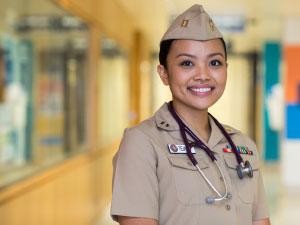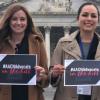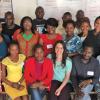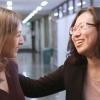![From left to right: Lieutenant Emily Latimer, Denise Mercer, Program Coordinator Lynda Mackin, Lieutenant Commander Nancy Helfrich, Tomoko Takano, Christa Perryman and Sara Cohen. (Photo by Dionicio Layugan [USN, ret.].)](/sites/nursing.ucsf.edu/files/styles/news_full/public/2023-01/UCSF_Nursing_VA_Navy2.jpg?itok=4eVPo0MO)
From left: Lieutenant Emily Latimer, Denise Mercer, Program Coordinator Lynda Mackin, Lieutenant Commander Nancy Helfrich, Tomoko Takano, Christa Perryman and Sara Cohen (Photo by Dionicio Layugan [USN, ret.])
Navy Nurses Bring Their “Honor, Courage and Commitment” to UCSF
Military veterans and reserve and active-duty military personnel have long made up a percentage of UC San Francisco School of Nursing’s faculty and students, but over the past few years, the pipeline from the United States Navy to the School has grown, garnering benefits for both organizations.
“UCSF is developing a great reputation in the Navy nursing community for the quality of its education,” says Lieutenant Commander Nancy Helfrich, a second-year master’s degree student in the Adult-Gerontology Clinical Nurse Specialist (AG CNS) Critical Care/Trauma program.
According to Lynda Mackin, who coordinates the AG CNS program, it’s been a great experience for the School as well. The Navy nurses contribute not only their unique life experiences, but also a Navy culture that has a lot to offer a system of modern health care in the throes of rapid change.
Three Distinct Personalities and Backgrounds
In 1996, Helfrich was a single mother in Los Angeles, struggling to go to college and raise two children. She joined the Navy in search of a better life.
Her first assignment was as one of the first women to serve as an undesignated seaman on a destroyer ship. Eight years later, she successfully applied to a Navy program that enabled her to attend nursing school; she began her nursing career at the Naval Medical Center in Portsmouth, Virginia, assisting on a complex obstetrics/gynecological surgeries unit. She had been there only a short time, however, when the Navy assigned her to Haiti aboard the USNS Comfort, to aid rescue efforts in the aftermath of the 2010 earthquake. “It was an amazing experience,” she says. “We had 48 hours to get ready for our deployment, and we were working every single day for almost a month.”
When she returned, she requested and received a transfer to the intensive care unit (ICU), having discovered a passion for critical care nursing. “The patients are so sick, and we can make a real difference,” she says. Since then, she has completed a tour in Guam and, in 2015, an around-the-world deployment aboard the USS Theodore Roosevelt, serving as the sole nurse for more than 5,000 naval personnel. Today, she is one of three Navy nurses enrolled in the AG CNS program, along with Lieutenant Emily Latimer and Lieutenant Maria Tejada.
Latimer grew up in Louisiana and decided on a nursing career while still in high school. “I wanted to travel, and I knew I could probably find employment anywhere,” she says.
During her second year at McNeese State University in Louisiana, she met her future husband, who was thinking of joining the Navy. It was Latimer who wound up being commissioned, drawn to the adventure, but also to signing bonuses that were critical to completing her undergraduate education without debt.
After graduating with her BSN degree in 2010, she began her nursing career in labor and delivery and then the emergency department (ED) in Norfolk, Virginia. Eventually, she shipped off to Guam for three years, where she became part of the ED leadership team – and where a mentor told her about UCSF. The chance to live in San Francisco along with the School’s programs and willingness to work with the Navy’s special requirements convinced her to apply.
 Maria Tejada (photo by Elisabeth Fall) Tejada arrived in Guam from the Philippines at age 7; the family moved to Hawaii a few years later. After she earned her BSN degree from Hawai’i Pacific University in 2011, the military offered her an opportunity to travel, pay back her student loans and give back to a country that had afforded her and her family opportunities that many of her relatives who remained in the Philippines could not enjoy.
Maria Tejada (photo by Elisabeth Fall) Tejada arrived in Guam from the Philippines at age 7; the family moved to Hawaii a few years later. After she earned her BSN degree from Hawai’i Pacific University in 2011, the military offered her an opportunity to travel, pay back her student loans and give back to a country that had afforded her and her family opportunities that many of her relatives who remained in the Philippines could not enjoy.
After serving at Walter Reed National Military Medical Center, in Bethesda, Maryland, she was stationed at a U.S. Navy hospital in Italy, where she delivered care to patients from other countries under the NATO alliance. That – and having traveled to 21 countries in Europe and Africa over the last few years – has “given me a taste of global health nursing,” she says. She is enrolled in the AG CNS Oncology program.
Semper Gumby, Blooming Where Planted and Training to Lead
Though Helfrich, Latimer and Tejada have different life stories, their Navy training has ingrained core values that all three embrace.
“In the Navy, your wants and wishes come second to what the organization needs; that’s what you sign up for,” says Latimer. “I didn’t want to work in labor and delivery, but the Navy asks you to bloom where you’re planted, to learn everything you can while there. The term we use is Semper Gumby [always flexible]; be willing to try new things. And L and D turned out to be a very valuable experience when I moved to the ED. If you’ve never seen an emergency delivery before, it’s easy to be scared or not recognize something that requires immediate action.… I had knowledge other emergency nurses didn’t have.”
“You have to be flexible, because you move every few years,” says Tejada. “I have various nursing experiences in medical-surgical, hematology/oncology, pre- and postanesthesia and postpartum care because the Navy wants you to be well-rounded and ready for change. That’s helped me a lot in the move to UCSF, to a new city, to a civilian environment.”
The Navy also encourages its nurses to embrace positions of leadership; to remain in the Navy as a career, you have to continually take on a larger role. “The Navy doesn’t let you get stagnant,” says Helfrich.
“As soon as you have the basics of the job down, you become a charge nurse, you train, you teach classes,” says Latimer. “Leadership relies on active-duty nurses to take the lead, and it rewards people who seek out extra experiences.”
Acceptance of Diversity Tied to Shared Goals
All three say they have also benefited from rich interactions with people from different cultures and different parts of the country and the world.
“You get to know people who didn’t grow up the U.S., who enlisted to become citizens. People from U.S. territories who want to serve their country – even though their country doesn’t let them vote for president,” says Latimer. “People in the military are incredibly good at putting aside personal differences to get the job done.”
“[It’s easier to understand] a variety of viewpoints and backgrounds in the Navy, because we’re all here for a common goal, whether it’s running an ICU or ER or putting a ship into Haiti with hospital capabilities,” says Helfrich.
Tejada says that shared sense of mission and respect for others can help individuals excel in a variety of settings – and directly apply to being a nurse. “Punctuality. Respect. Commitment. Service. Teamwork. They’re all huge in the military and in nursing,” she says. “And the military is 24/7. I know I’m representing the Navy every day, in everything that I do.”
Helfrich uses similar language. “Honor, courage and commitment,” she says. “Honor to do the right thing when nobody’s looking. Having the courage to speak up, from junior enlisted people on up. And commitment to getting the job done. These are our shared values.”
Embracing Graduate Nursing Education
Those values also have helped the nurses embrace the challenges of graduate school – with the help of an employer fully supportive of its nurses pursuing advanced practice educations. In exchange for a promise of four more years of military service, the Navy pays the full freight for the nurses’ two-year master’s degree program, while also continuing to pay them full salary and benefits. Their sole job is to be a student.
“I feel very fortunate,” says Tejada. “So many of my classmates have to work throughout the program.” She also feels fortunate for having found a program that gives her the opportunity to focus intensively on oncology care – a true passion. “It is so different than undergraduate education. Professors treat you like a colleague. Everyone truly wants you to succeed, and I can feel that here at UCSF. I enjoy learning with the other CNS students in my cohort and love that we each have unique experiences to share with each other. Being here makes me understand how much more I have to learn,” she says.
“Lynda [Mackin] does such a great job,” says Latimer. “She is so thoughtful about putting together experiences that expose us to new ideas and experiences we wouldn’t have on our own. There are phenomenal lectures, exposure to different teaching methodologies, and my clinical experiences have been amazing because Lynda pairs us with preceptors who give us a very good picture of better ways we can do the job in future.”
“I would recommend it to anybody in a heartbeat,” says Helfrich.



